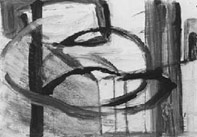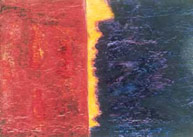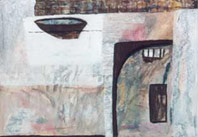


Kilmainham Suite - Review, Artist's Association of Ireland Art Bulletin, Feb/March 2000
For Sally Smyth taking the first tentative steps in
approaching Kilmainham Gaol to see if she could spend some time
there observing, drawing, possibly seeing archives, was the start
of a journey that had really begun in 1938 when Sally as a small
child was brought by her mother and shown the cell where she had
been a political prisoner.
Her mother May Gibney had for at least
five months been a prisoner in Kilmainham during the Civil War in
1923. Kilmainham had become part of the family mythology but as
time went on its significance and meaning was something that Smyth
needed to explore for herself.
Exploring family stories is an emotional minefield at the best of
times, added to that, the historical weight and presence of Kilmainham
made it a daunting task. Fired with a belief in the need to do this,
Smyth asked for permission to observe and familiarise herself with
the gaol. This initial start led to a major project which was to
last for over one year.
Many issues arose including:
How to find her own voice and vision in an environment that is loaded with historical meaning, and seductive as regards the physical presence and overpowering atmosphere of the building?
How to find boundaries between recording historical facts and becoming illustrative?
How to maintain a respect for the privacy of her mother while exploring areas that were fragile and personal?
How to find a language to deal with these concerns?
Why be there at all?
These and many more issues shaped the project, which grew into a major commitment and involvement on the part of Smyth and the staff of Kilmainham.
Access was given to the archives and to spaces within the gaol. This led to a working space / studio being given, followed by a bursary. Part of this development was the openness on the part of the manager and staff of Kilmainham, but also tha trust and ongoing dialogue initiated by the artist. This resulted in a working relationship, which allowed creativity to develop in a supportive environment and streched the possibilities within the project.
Smyth produced a large body of paintings, drawings, an artist's book, endless studies and two videos. One video recorded an overnight in a re-constructed cell using the limited of a cell of that period, a bed on the floor, a bucket, a candle, a bible, a table and a stool.
The final work exhibited in the main compound of the East Wing comprised of 33 large paintings and an artist's book.
One of the strengths of Smyth's work was the fact that she handled a very emotive subject in an unsentimental way. She allowed the language of paint to express itself in a semi-abstract form creating a quiet confidence and clarity with emotional punch. In lesser hands this work could have become overloaded with emotional and historical imagery.
Smyth handled this difficult area by a suggested use of imagery. What was left out, the unspoken, was as potent as the spoken. This suggestive use of the colour and imagery was particularly strong in Erknellen, a reference to the bell rung after an execution. In this piece the bell is left out but a ghostly bell shape remains, surrounded by a blood-like darkness. The restrained use of drips of paint on the bell shape adds a visual tension. The surrounding space is looming and ominous with the hint of prison bars ever present in the corner.
Smyth's work was not limited to her mother's story but tried to reflect other stories in the prison.
She Kept Her Resolve is about Anne Devlin, and refers to the mat on which she slept. This mixed-media piece has a rectangle of matting, fibrous, frayed at the edges, sinuous, the texture is itchy and knotted and tense but resilient. The frayed edges float into a blue space, which seems to sing of hope.
Oh! Phytophtora Infestans - this piece deals with potato blight and famine. This haunting piece suggests the shape of a potato, which vaguely resembles a human head, festering and lurking beneath the surface. It has carved out its own space, its own power. It is pushing upwards, there is no mistaking the sense of menace and foreboding in this piece.
Smyth handles all the work with a maturity and sensivity, and she seems to have found a balance between respecting the privacy of her mother's life while managing to tell her story.
The integrity and hard work of the artist and a willingness to establish a dialogue led in part to the success and development of the project. Smyth's is the first painting solo and in-depth exploration taken on by a daughter or son of a Kilmainham Gaol prisoner. A broad ranging project like this shows the potential; for individual artist's initiatives in establishing links, and potential links, with public bodies.
Patricia McKenna
